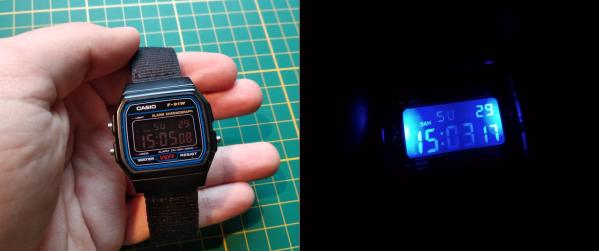The Casio F-91W is easily one of the most iconic and popular watches worldwide. But what’s cool about having the same exact thing as millions of other people? Not much, unless of course you modify it to make it your own. That’s exactly what [Gautchh] did to their beloved watch. Between permanent dark mode, stereo blue LED backlights, and a new strap, this timepiece really stands out from the crowd.
Once [Gautchh] got the watch open, the first order of business was to re-polarize the LCD with a different film so the digits are light and the background is dark. This watch ships with a single green backlight LED that’s fairly faint, so [Gautchh] upgraded it to bright blue and added a second 1206 LED in parallel on the other side of the readout. Finally, they replaced the rubber strap with something less likely to chafe.
We think dark mode looks great, though [Gautchh] says it requires a little bit of training to hold your wrist just right to make it readable. They make these mods look easy, but they likely aren’t for the faint of heart. If you want to give it a shot, there are good step-by-step instructions and several pictures to help out.
We’ve seen a lot of Casio F-91W projects over the years, including a method for waterproofing the internals. If you have a lot of love for this watch, why not make a giant version?





 [Wilfred] was testing a titanium 3D printer at work and was looking for something to print. The skull ‘n wrenches was a suitable candidate, and the results are fantastic. From [Wilfred]: “Just out of the printer the logo looks amazing because it isn’t oxidized yet (inside the printer is an Argon atmosphere) Then the logo moves to an oven to anneal the stress made by the laser. But then it gets brown and ugly. After sandblasting we get a lovely bluish color as you can see in the last picture.”
[Wilfred] was testing a titanium 3D printer at work and was looking for something to print. The skull ‘n wrenches was a suitable candidate, and the results are fantastic. From [Wilfred]: “Just out of the printer the logo looks amazing because it isn’t oxidized yet (inside the printer is an Argon atmosphere) Then the logo moves to an oven to anneal the stress made by the laser. But then it gets brown and ugly. After sandblasting we get a lovely bluish color as you can see in the last picture.”









